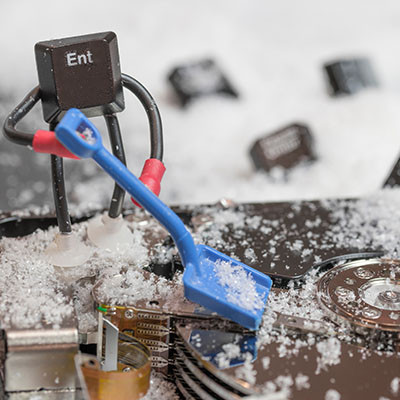According to the weather forecast, we Marylanders are in for a winter that is unreasonably cold and unreasonably snowy. Based on our experience, that’s the exact recipe for weather-induced business disasters. We strongly, strongly recommend that you ensure that you have your business continuity plans in order.
Let’s go into what this involves, piece by piece.
How to Prepare Your Data Backups
Data backup is critically important for modern businesses, as there is no shortage of ways that the data loss they counteract can occur:
What if Tim in accounting reaches for the + key, but actually hits his large iced coffee with oat milk and pumpkin swirl onto his laptop?
What if the shelving you use in your server room suddenly fails, and one expensive piece of hardware comes crashing down on top of the other?
What if a ransomware attack finds its way onto your network, encrypting all of your files unless you pay a $5000 ransom?
What if a hurricane comes by and floods your business from top to bottom, thoroughly soaking every piece of hardware you have?
The right backup strategy addresses all these circumstances and more, simply by ensuring that all of them are covered by the strategy’s scope. Rather than losing your data, keeping a backup helps ensure you have a copy of everything tucked away to fall back on.
This is why we typically recommend that businesses approach their backups in the following way, commonly referred to as the 3-2-1 Backup Rule:
- 3. You keep (at least) three separate and distinct copies of your data.
- 2. These copies of your data are kept in at least two separate and distinct media types, so that your backups aren’t all saved on a single server.
- 1. One of these copies should be kept off-site, ideally in the cloud, which should layer its own protections on top of your own efforts.
You should also ensure that your backups are taken as often as possible, so as to minimize any data lost if the need to restore presents itself. Our backup solutions can automatically backup any changes made to your data—down to edits made on a document—every 15 minutes or so, maximizing the data that the backup protects. In addition, your backups should stack, allowing you to go back to previous versions in case you need to restore your data from father back in time.
Your backup solution needs to take restoration into consideration too. Older backup solutions like tape were notoriously slow and unreliable when it comes to restoring your data. Consumer-based backup solutions don’t offer the same flexibility, functionality, or security either. While any backup is better than no backup, a backup solution that could take days to restore onto new hardware won’t really fit into a disaster recovery model. Our backup solution will allow us to run your servers virtually directly from the device or even from the data center, so you can get back up and running within minutes or hours as opposed to days or weeks.
How to Plan Your Disaster Recovery
Once your backups are in order and your data is safe, it’s time to address how you plan to withstand and bounce back from whatever disaster strikes. This plan needs to cover a considerable amount, including the chain of command, how you’ll reestablish communications and operations once things settle, and how you’ll communicate with your clients and vendors to keep them apprised of the situation.
Your disaster recovery plans also need to identify the policies, tools, and overall processes required to keep everyone safe throughout the event. Seriously, there’s a whole lot more that this plan needs to cover, so don’t hesitate to reach out to us for more personalized and customized assistance.
Combined, your backups and your disaster recovery planning create a system known as a BDR (predictably, short for Backup and Disaster Recovery) strategy. The BDR strategy you create plays heavily into the next step: your overall business continuity plan.
How to Put Together Your Business Continuity Strategy
Business continuity is effectively the compilation of the two aforementioned elements, working together to ensure that your business processes can and will resume as quickly as possible after a disaster—if they are interrupted by the disaster at all. As a result, it needs to create an actionable plan for your team members to follow.
Using this kind of strategy can help you minimize the time it takes for your business to return your operations to an acceptable state—two metrics that are known as your recovery time objective and your recovery point objective.
Once again, this is all something we can assist you with throughout, and are more than happy to do so. Don’t let the winter weather (or any other disaster) hurt your business’ longevity. Give us a call at (410) 531-6727 to get started today!



